Should you wire RV batteries in series vs parallel? That’s a great question and knowing the correct answer is really important. If we had a dollar for every time we’ve been asked, “Are RV batteries wired in series or parallel?” we’d have enough to fill our diesel pusher’s fuel tank.
But we can’t just give a blanket answer because it depends on a few different factors. There are situations in which you’ll want to wire your batteries in series, and there are other situations where wiring RV batteries in parallel works best. And, of course, series-parallel is a very common configuration, too.
For example, if you were to ask us how to wire 2 6-volt RV batteries, we’d give you one answer, but if you were to ask us how to wire 4 6-volt batteries for RV use, we’d give you a different answer. If you said you wanted to wire several 12-volt batteries together, we’d give you yet another answer. Three different answers for three different situations.
And to confuse things a little more, we’d want to know your goal in wiring your batteries together. Are you looking to increase your battery bank’s capacity or its voltage? The answer to that question takes into consideration the devices and appliances you’re powering and is key to knowing how you want to connect your batteries.
So, in today’s post, we’re going to sort out all the particulars so you’ll have a guide to follow based on the type and number of batteries you have in your RV… and what you’re trying to accomplish.
Wiring RV Batteries in Series vs Parallel: What’s the Difference?
Whether you’re working with flooded lead-acid (including gel or AGM) or lithium batteries, the following information is true. (See our RV battery guide for more on RV battery types.)
The difference between connecting batteries in series vs parallel is that connecting in series will increase the voltage of your battery bank, and connecting the batteries in parallel will increase your battery bank’s capacity (amp hours).
Those are the two simplest ways to wire batteries together. But, a third option exists for wiring sets of batteries together in a series-parallel connection, which would increase both the voltage and the capacity.
Let’s take a look at how to wire batteries in each of these three ways and what the result of doing each would be.
Note: Whether you wire your batteries in series or parallel, all the batteries in the bank must be the same voltage and capacity rating. Mixing voltages and capacities can damage your batteries.
Wiring RV Batteries in Parallel
Connecting RV batteries in parallel is simple. A parallel connection connects the batteries’ terminals, positive to positive and negative to negative. When you connect batteries in parallel, you increase your battery capacity (which means you increase the amp hours), but the voltage stays the same.
So, let’s say you have two 12-volt batteries, each with a capacity of 100 amp hours (Ah). To wire them together in parallel, you’ll connect the positive terminal (+) of the first battery to the positive terminal (+) of the second battery, and you’ll connect the negative terminal (–) of the first battery to the negative terminal (–) of the second battery.
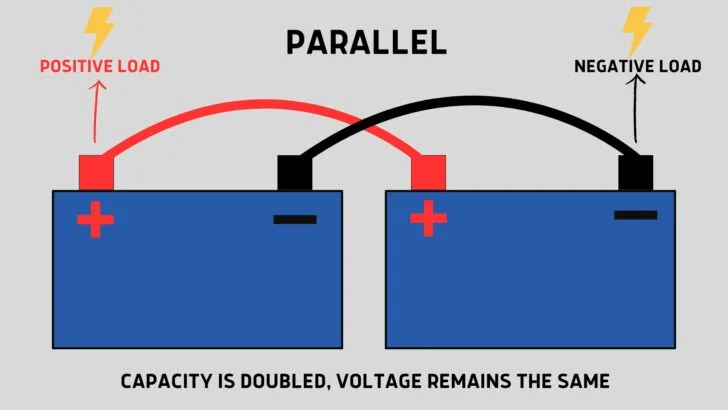
This illustration shows two batteries wired in parallel: positive to positive and negative to negative.
In doing this, you’ve increased the total capacity of your battery bank to 200Ah, but the voltage will remain at 12 volts. If you were to add a third battery, you’d have 300Ah @ 12V. Adding a fourth battery would give you 400Ah @ 12V, and so on.
Thus, wiring your RV batteries in parallel combines multiple batteries to increase the available power that can be stored, without increasing the output voltage.
Here’s an illustration of three batteries connected in parallel:
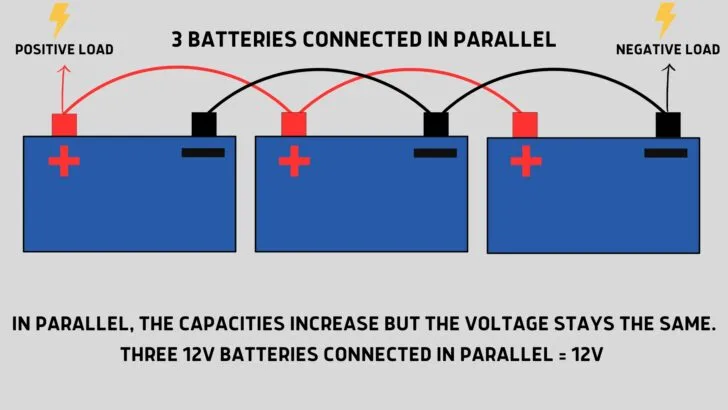
With three batteries connected in parallel, you’re tripling the capacity while the voltage remains the same.
Pros of Parallel Wiring
The benefit of wiring a battery bank in parallel is that you’re increasing the capacity of your system with each battery added to the bank. This means you’ll have more power available for longer, the more batteries you add to the configuration.
Another benefit of connecting your batteries in parallel is that if one of the batteries dies, the other batteries can still provide power to your RV (so you won’t be stranded, but the lifespan of the remaining batteries will be significantly reduced if you don’t replace the dead unit).
Cons of Parallel Wiring
The main disadvantage of wiring batteries in parallel is that charging time will be increased. Without also increasing the capacity of your RV’s battery charger, it may become impractical to completely recharge your battery bank if it gets too large.
Wiring RV Batteries In Series
Connecting batteries in series accomplishes the opposite goal: a series connection adds together the voltage but doesn’t combine the capacity. For example, this is often done with two 6-volt, deep cycle (“golf cart”) batteries.
You use this technique when you want to combine two lower (same) voltage batteries into one larger, double-voltage bank. To wire batteries together in series, you’ll connect the first battery’s positive (+) terminal to the second battery’s negative (–) terminal.
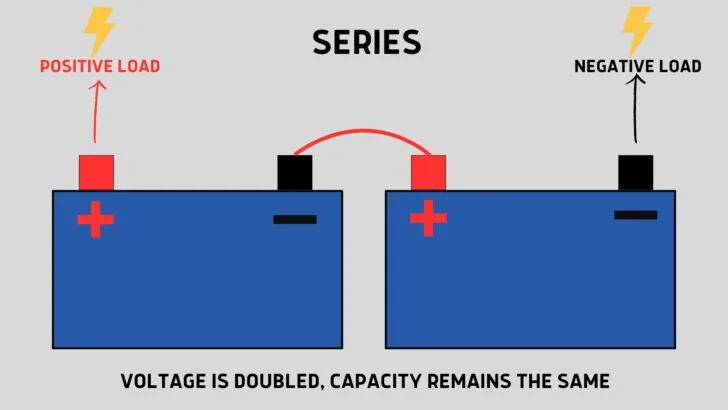
When you wire two batteries together in series, you’re doubling the voltage while the capacity remains the same.
Wiring two 6V batteries together in series creates what is essentially one larger-capacity 12V battery.
Similarly, if you were to wire two 100Ah 12V batteries together in series, you’d end up with a 24V battery bank with a 100Ah capacity. You’ve doubled the voltage but the reserve capacity remains the same.
Here’s an illustration of three batteries connected in series:
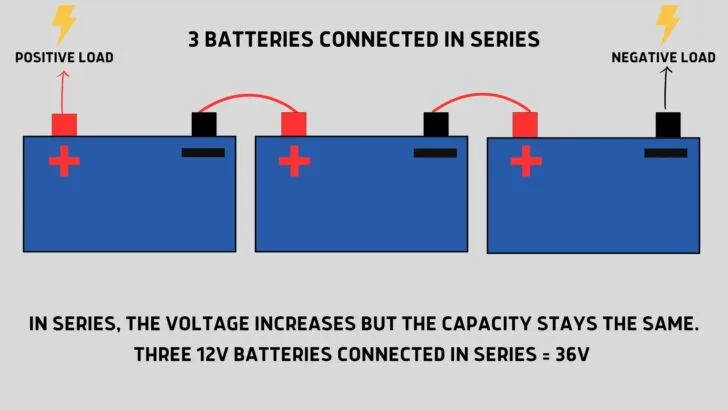
When you connect three batteries in series, you’re tripling the voltage while the capacity remains the same.
You might wonder why you’d want to connect your batteries in such a way that the amp hours wouldn’t be increased, but the voltage would.
Pros
Using a pair of 6V deep cycle lead-acid batteries wired in series to create one larger 12V battery will typically provide you with greater capacity than a single 12V battery. That’s because 6V batteries typically have greater amp-hour capacity than their same-size 12V counterparts due to thicker and more robust lead plates.
Another benefit to wiring your battery bank in series is that you’ll be able to use lighter, thinner, more flexible, and less expensive wire. There’ll also be less of a voltage drop in your system.
Cons
When you wire a battery bank in series, you can’t obtain lower voltages from that system without a converter (i.e. if you wired two 12V batteries in series to create a 24V bank). So, either all of your devices and appliances need to be able to operate at the higher voltage, or you need a converter for use with your lower-voltage appliances.
Wiring RV Batteries in Series-Parallel
Wiring sets of batteries in series-parallel sounds a bit more complicated. Still, once you understand that you’re dealing with connecting (in parallel) sets of batteries that are then wired in series, it becomes clearer.
For example, this is where you can take four 6V batteries to create one large 12V battery bank.
To do this, you’d wire two pairs of 6V batteries together in series (making each pair 12V), and then wire those two sets together in parallel, to combine their capacity.
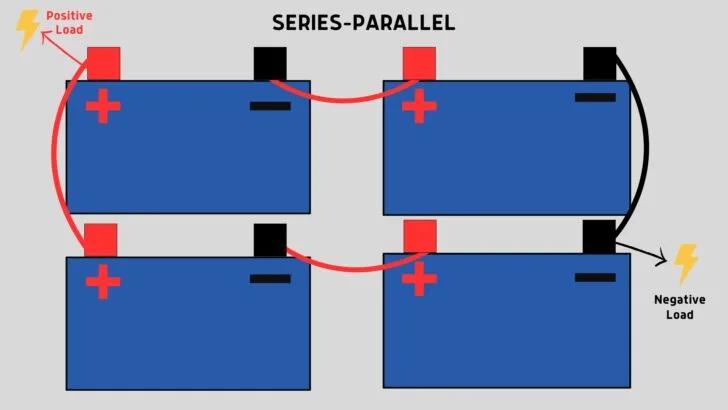
When you wire 4 batteries together in series-parallel, you wire 2 batteries together in series (+ to –), creating a set. You then wire the other 2 batteries together in series (+ to –), creating a second set. Finally, you wire the two series sets of batteries to each other in parallel. (See a video demonstrating this on YouTube)
Likewise, you could wire two 12V batteries together in series resulting in 24V, and then wire that first set in parallel with another set of 24V batteries.
The important thing here is to consider each set of series-wired batteries as one battery. Then you bring together a second set of batteries with equal voltage to the first and wire the two sets together in parallel.
The advantage of wiring in series-parallel is that you’re increasing both the voltage and the battery bank’s capacity.
RV Batteries in Series vs Parallel: Which is Better?
Generally, the choice between connecting your RV batteries in series vs parallel depends primarily on the devices and appliances you’ll be powering.
As you’ve seen above, wiring your RV batteries in parallel involves the simplest wiring while maintaining the common voltage. But, for systems that require more power, (say anything beyond 3000 watts), and for larger solar systems, using series connections to provide more voltage is usually best.
If you want to wire your battery bank to increase both voltage and capacity, you’ll want to opt for wiring your system in series-parallel.
Remember that it’s always best to use batteries of the same chemistry, age, voltage, and capacity ratings when you’re creating a battery bank. And if you’re considering doing any work on your RV’s battery bank, you may need a couple of tools like the following:
- Measures both ac & dc current up to 400 amps, ideal for vehicles, rvs, marine boats & etc
- Ac/dc voltage, current, resistance, frequency, continuity, duty cycle & diode check
- 【Versatilel】For AWG 8,6,4,2,1,1/0 battery cable lugs, compatiable with copper&aluminum cable lug,non-welding and standard electrical connection.
- 【Product upgrade】It will bring embossing AWG value to the cable lugs after crimping for a visual checking. Facilitates the selection of the...
- 【What You Get:】 10 Pcs per pack of 00 Guage (AWG) 3/8" ring terminals copper lugs closed end termination ring terminals with 10 Pcs 3:1 Dual Wall...
- 【Quality Material:】 The TKDMR bare copper battery cable ends are made from 100% annealed copper with special treatment surface for corrosion...
And if you’re re-doing your battery bank, consider upgrading your RV’s batteries to lithium with Battle Born Batteries:
For more on matters related to your RV batteries, check out our posts entitled “Should I Disconnect My RV Battery When Plugged Into Shore Power?“, “What is an RV Battery Disconnect Switch?“, or RV Battery Guide: House, Chassis, Lithium & More.
And if your RV’s electrical system often leaves you scratching your head, confused? Check out our article, “RV Wiring For Dummies: Don’t Be Shocked By What You Don’t Know” to learn more.
Free RVing Tips, Tricks, Reviews, Giveaways & More
Subscribe to our daily newsletter! We’ve been full-time RVers for 20 years (!) and share everything we’ve learned about RVing in our daily blog posts. Join our online community to receive a wealth of great RVing knowledge delivered right to your inbox.
Whether this is your first time on the road or you’re a seasoned full-timer, you’ll love the wide range of RVing topics we cover. Don’t miss a single article or any of our famous RV gear Giveaways — Subscribe today!




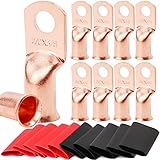

Mark Robbins
Tuesday 4th of July 2023
Do you need to use a trickle charger if you keep your RV plugged in all the time?